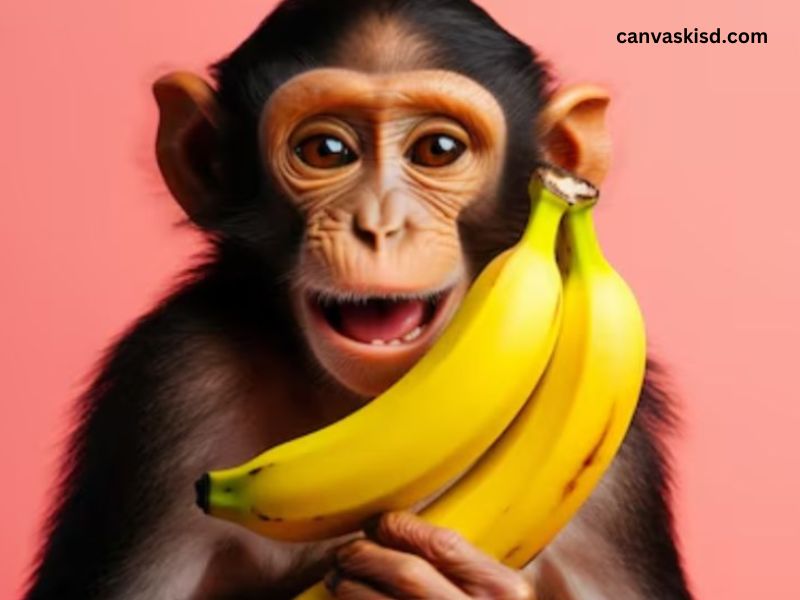Bananas are among the most popular fruits worldwide, beloved for their sweetness, convenience, and nutritional benefits. But the relationship between bananas and monkeys is particularly fascinating, intertwining elements of ecology, evolution, and even cultural symbolism. In this article, we’ll explore the significance of bananas in the lives of monkeys, their ecological roles, and how this relationship reflects broader themes in nature.
The Banana Plant: A Quick Overview
The banana plant (Musa spp.) is often mistaken for a tree, but it is technically a large herbaceous flowering plant. It thrives in tropical and subtropical regions, growing best in areas with ample rainfall and sunlight. The banana plant has a unique structure, with a pseudostem composed of tightly packed leaf bases that can reach heights of 30 feet.
Bananas are rich in essential nutrients, including potassium, vitamin C, and dietary fiber. Their soft, sweet flesh and convenient, portable nature make them an ideal snack for many, including monkeys.
Monkeys and Their Diet
Monkeys belong to the primate order and are found in various regions, primarily in tropical forests. They are omnivorous, which means their diet includes fruits, leaves, seeds, flowers, insects, and small animals. The specific diet varies by species, habitat, and food availability. Bananas are a favored food source for many monkey species, providing not only energy but also essential nutrients.
Species of Monkeys That Love Bananas
- Capuchin Monkeys: Known for their intelligence and dexterity, capuchins are often seen using tools. They enjoy a diverse diet, and bananas are a significant part of their fruit consumption.
- Spider Monkeys: These monkeys have long limbs and prehensile tails, allowing them to navigate the treetops easily. They primarily eat fruits, and bananas are a staple in their diet.
- Howler Monkeys: Famous for their loud calls, howler monkeys primarily consume leaves but will also eat fruits like bananas when available.
- Macaques: Found in various regions, including Asia and North Africa, macaques are known to adapt well to human environments. They often raid farms and markets for bananas and other fruits.
The Ecological Role of Monkeys
Monkeys play a crucial role in their ecosystems, particularly in tropical forests. Their fruit-eating habits contribute significantly to seed dispersal. When monkeys consume bananas and other fruits, they help in spreading seeds throughout their habitat via their feces. This process promotes plant diversity and helps maintain healthy ecosystems.
Seed Dispersal and Forest Regeneration
Monkeys are effective seed dispersers. As they move through the forest, they consume fruits and then deposit the seeds in different locations. This not only aids in the propagation of various plant species but also helps regenerate forests, especially after disturbances such as storms or human activity. The bananas and other fruits they consume often lead to the growth of new plants, creating a cycle of growth and renewal.
The Evolutionary Perspective
The relationship between monkeys and bananas is also of evolutionary significance. The evolution of fruit-bearing plants and their dispersers is a classic example of co-evolution, where two species evolve in response to each other. Bananas, like many other fruits, have developed characteristics that attract fruit-eating animals, ensuring their seeds are spread over wide areas.
Traits of Bananas That Attract Monkeys
- Color and Scent: Ripe bananas turn bright yellow and emit a sweet fragrance, signaling their readiness for consumption. These traits attract monkeys and other animals, ensuring the bananas are eaten and their seeds dispersed.
- Nutritional Value: The high carbohydrate content in bananas provides monkeys with quick energy, making them an ideal food source, especially for active species that require a lot of energy.
Cultural Symbolism
In addition to their ecological importance, bananas and monkeys have found a place in human culture. From cartoons and children’s literature to folklore and religious symbolism, the image of the monkey with a banana has become iconic.
Monkeys in Popular Culture
The playful depiction of monkeys with bananas is prevalent in media. From cartoons featuring mischievous monkeys to films showcasing their intelligence and antics, the monkey-banana duo represents fun and curiosity. This representation often reinforces the idea of monkeys as playful and intelligent creatures.
Bananas as a Cultural Symbol
Bananas themselves have cultural significance in various societies. In some cultures, they symbolize fertility and prosperity, while in others, they are seen as symbols of abundance and good fortune. This connection to both monkeys and bananas enriches the cultural narratives surrounding them.
Human Interaction with Monkeys and Bananas
The relationship between humans, monkeys, and bananas has evolved, especially in agricultural settings. As bananas became a staple crop in many regions, the interaction with local monkey populations changed.
Monkeys as Pests
In agricultural settings, monkeys are often viewed as pests. They can raid banana plantations, causing significant damage and leading to conflicts between farmers and wildlife. This has sparked debates about wildlife management, conservation, and the ethics of protecting crops versus preserving natural habitats.
Conservation Efforts
In light of these conflicts, various conservation efforts have been initiated to protect both monkey populations and agricultural interests. Solutions range from building barriers to prevent monkey access to plantations, to creating alternative food sources or compensation programs for farmers affected by wildlife.
Bananas and Monkeys in Science
The study of bananas and their relationship with monkeys extends into the realm of science, particularly in fields like ecology, biology, and anthropology. Researchers examine how primates interact with their environment and the implications for conservation strategies.
Behavioral Studies
Behavioral studies of monkeys provide insight into their foraging habits, social structures, and intelligence. Understanding how monkeys choose fruits, including bananas, helps researchers gauge the health of their habitats and the availability of resources.
Conservation Biology
Conservation biology focuses on preserving biodiversity and understanding the dynamics between species. The role of monkeys in seed dispersal and forest regeneration makes them critical to conservation efforts. Protecting monkey populations can, in turn, benefit the banana plants and overall ecosystem health.
The Future of Bananas and Monkeys
As we look to the future, the relationship between bananas and monkeys will continue to evolve. Climate change, habitat destruction, and agricultural practices all impact both species. Preserving their relationship is crucial for maintaining ecological balance and ensuring the health of tropical ecosystems.
Sustainable Practices
Encouraging sustainable agricultural practices can help mitigate human-monkey conflicts. Agroforestry, where crops and native vegetation coexist, allows for both farming and wildlife conservation. This approach can provide food for both humans and monkeys while promoting biodiversity.
Education and Awareness
Raising awareness about the ecological roles of monkeys and the importance of bananas in their diets can foster a greater appreciation for wildlife. Educational initiatives that highlight the benefits of biodiversity can encourage people to protect both species and their habitats.
Conclusion
The relationship between bananas and monkeys is a captivating intersection of ecology, evolution, and culture. Monkeys rely on bananas for sustenance, while bananas depend on monkeys for seed dispersal, creating a vital partnership in tropical ecosystems. As we navigate the complexities of human-wildlife interactions, understanding and preserving this relationship is essential for a sustainable future. By appreciating the roles both species play in their environments, we can work towards a harmonious coexistence that benefits both nature and humanity.




